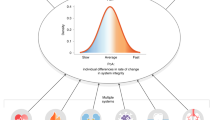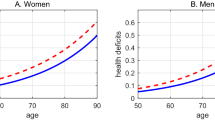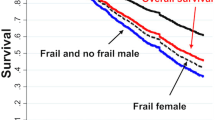Abstract
Survivors of childhood cancer may experience accelerated biological aging, resulting in premature frailty and death. We used seven measures of biological age in the St. Jude Lifetime (SJLIFE) Cohort to compare biological age acceleration between the SJLIFE Cohort and the third United States National Health and Nutrition Examination Survey controls, explore trajectories of biological age according to cancer treatment and type, and test associations of biological age acceleration with frailty and death (mean follow-up of 26.5 years) among survivors. Survivors of cancer aged 5% faster per year and measured, on average, 0.6–6.44 years biologically older compared to controls and 5–16 years biologically older compared to age-matched individuals at the population level. Survivors treated with hematopoietic cell transplant and vinca alkaloid chemotherapy evidenced the fastest trajectories of biological aging. Biologically, older and faster-aging survivors consistently and robustly had a higher risk of frailty and died earlier than those with slower biological aging, suggesting a potential opportunity to intervene on excess aging.
This is a preview of subscription content, access via your institution
Access options
Access Nature and 54 other Nature Portfolio journals
Get Nature+, our best-value online-access subscription
$29.99 / 30 days
cancel any time
Subscribe to this journal
Receive 12 digital issues and online access to articles
$119.00 per year
only $9.92 per issue
Buy this article
- Purchase on Springer Link
- Instant access to full article PDF
Prices may be subject to local taxes which are calculated during checkout



Similar content being viewed by others
Data availability
The dataset supporting the findings of this study has been deposited in Zenodo and is publicly available online at https://doi.org/10.5281/zenodo.1003525 and https://stjude.cloud. The DNA methylation data used in this study are accessible at the NCBI Gene Expression Omnibus website under accession no. GSE197674 for survivors and accession no. GSE197676 for controls. Source data are provided with this paper (Supplementary Data 2). All other data supporting the findings of this study are available from the co-corresponding authors upon reasonable request.
Code availability
The code supporting this study’s findings is publicly available at https://doi.org/10.5281/zenodo.10035257 (ref. 45) and are provided in Supplementary Data 1.
References
Howlader, N. et al. SEER Cancer Statistics Review 1975–2014 (National Cancer Institute, 2017); https://seer.cancer.gov/csr/1975_2014/
Henderson, T. O., Ness, K. K. & Cohen, H. J. Accelerated aging among cancer survivors: from pediatrics to geriatrics. Am. Soc. Clin. Oncol. Educ. Book 34, e423–e430 (2014).
Guida, J. L. et al. Measuring aging and identifying aging phenotypes in cancer survivors. J. Natl Cancer Inst. 111, 1245–1254 (2019).
Ness, K. K. & Wogksch, M. D. Frailty and aging in cancer survivors. Transl. Res. 221, 65–82 (2020).
Hayek, S. et al. Prevalence and predictors of frailty in childhood cancer survivors and siblings: a report from the Childhood Cancer Survivor Study. J. Clin. Oncol. 38, 232–247 (2020).
Suh, E. et al. Late mortality and chronic health conditions in long-term survivors of early-adolescent and young adult cancers: a retrospective cohort analysis from the Childhood Cancer Survivor Study. Lancet Oncol. 21, 421–435 (2020).
Yeh, J. M. et al. Life expectancy of adult survivors of childhood cancer over 3 decades. JAMA Oncol. 6, 350–357 (2020).
Kohanski, R. A. et al. Reverse geroscience: how does exposure to early diseases accelerate the age-related decline in health? Ann. N. Y. Acad. Sci. 1386, 30–44 (2016).
López-Otín, C., Blasco, M. A., Partridge, L., Serrano, M. & Kroemer, G. The hallmarks of aging. Cell 153, 1194–1217 (2013).
Margolick, J. B. & Ferrucci, L. Accelerating aging research: how can we measure the rate of biologic aging? Exp. Gerontol. 64, 78–80 (2015).
Sulicka-Grodzicka, J. et al. Low-grade chronic inflammation and immune alterations in childhood and adolescent cancer survivors: a contribution to accelerated aging? Cancer Med. 10, 1772–1782 (2021).
Ariffin, H. et al. Young adult survivors of childhood acute lymphoblastic leukemia show evidence of chronic inflammation and cellular aging. Cancer 123, 4207–4214 (2017).
Daniel, S. et al. T cell epigenetic remodeling and accelerated epigenetic aging are linked to long-term immune alterations in childhood cancer survivors. Clin. Epigenetics 10, 138 (2018).
Gallicchio, L., Gadalla, S. M., Murphy, J. D. & Simonds, N. I. The effect of cancer treatments on telomere length: a systematic review of the literature. J. Natl Cancer Inst. 110, 1048–1058 (2018).
Gramatges, M. M. et al. Telomere content and risk of second malignant neoplasm in survivors of childhood cancer: a report from the Childhood Cancer Survivor Study. Clin. Cancer Res. 20, 904–911 (2014).
Qin, N. et al. Epigenetic age acceleration and chronic health conditions among adult survivors of childhood cancer. J. Natl Cancer Inst. 113, 597–605 (2020).
Smitherman, A. B. et al. Accelerated aging among childhood, adolescent, and young adult cancer survivors is evidenced by increased expression of p16INK4a and frailty. Cancer 126, 4975–4983 (2020).
Song, N. et al. Shortened leukocyte telomere length associates with an increased prevalence of chronic health conditions among survivors of childhood cancer: a report from the St. Jude Lifetime Cohort. Clin. Cancer Res. 26, 2362–2371 (2020).
Walsh, K. M. Telomere attrition in childhood cancer survivors. Clin. Cancer Res. 26, 2281–2283 (2020).
Ness, K. K. et al. Premature physiologic aging as a paradigm for understanding increased risk of adverse health across the lifespan of survivors of childhood cancer. J. Clin. Oncol. 36, 2206–2215 (2018).
Armenian, S. H. et al. Long-term health-related outcomes in survivors of childhood cancer treated with HSCT versus conventional therapy: a report from the Bone Marrow Transplant Survivor Study (BMTSS) and Childhood Cancer Survivor Study (CCSS). Blood 118, 1413–1420 (2011).
Williams, A. M. et al. Physiologic frailty and neurocognitive decline among young-adult childhood cancer survivors: a prospective study from the St Jude Lifetime Cohort. J. Clin. Oncol. 39, 3485–3495 (2021).
Ness, K. K. et al. Physiologic frailty as a sign of accelerated aging among adult survivors of childhood cancer: a report from the St Jude Lifetime cohort study. J. Clin. Oncol. 31, 4496–4503 (2013).
Arora, M. et al. Physiologic frailty in nonelderly hematopoietic cell transplantation patients: results from the Bone Marrow Transplant Survivor Study. JAMA Oncol. 2, 1277–1286 (2016).
Cupit-Link, M. C. et al. Biology of premature ageing in survivors of cancer. ESMO Open 2, e000250 (2017).
Arnold, N. et al. Promotion of arterial stiffness by childhood cancer and its characteristics in adult long-term survivors. J. Am. Heart Assoc. 10, e015609 (2021).
Howell, C. R. et al. Cohort profile: the St. Jude Lifetime Cohort Study (SJLIFE) for paediatric cancer survivors. Int. J. Epidemiol. 50, 39–49 (2021).
Hudson, M. M. et al. Prospective medical assessment of adults surviving childhood cancer: study design, cohort characteristics, and feasibility of the St. Jude Lifetime Cohort Study. Pediatr. Blood Cancer 56, 825–836 (2011).
Levine, M. E. Modeling the rate of senescence: can estimated biological age predict mortality more accurately than chronological age? J. Gerontol. A Biol. Sci. Med. Sci. 68, 667–674 (2013).
Liu, Z. et al. A new aging measure captures morbidity and mortality risk across diverse subpopulations from NHANES IV: a cohort study. PLoS Med. 15, e1002718 (2018).
National Health and Nutrition Examination Survey Data (1988–1994) (CDC, 2012); https://wwwn.cdc.gov/nchs/nhanes/nhanes3/default.aspx
Klemera, P. & Doubal, S. A new approach to the concept and computation of biological age. Mech. Ageing Dev. 127, 240–248 (2006).
Levine, M. E. et al. An epigenetic biomarker of aging for lifespan and healthspan. Aging 10, 573–591 (2018).
Wang, Z. et al. Genetic risk for subsequent neoplasms among long-term survivors of childhood cancer. J. Clin. Oncol. 36, 2078–2087 (2018).
Horvath, S. & Raj, K. DNA methylation-based biomarkers and the epigenetic clock theory of ageing. Nat. Rev. Genet. 19, 371–384 (2018).
Hannum, G. et al. Genome-wide methylation profiles reveal quantitative views of human aging rates. Mol. Cell 49, 359–367 (2013).
Lu, A. T. et al. DNA methylation GrimAge strongly predicts lifespan and healthspan. Aging 11, 303–327 (2019).
Belsky, D. W. et al. Quantification of biological aging in young adults. Proc. Natl Acad. Sci. USA 112, E4104–E4110 (2015).
Elliott, M. L. et al. Disparities in the pace of biological aging among midlife adults of the same chronological age have implications for future frailty risk and policy. Nat. Aging 1, 295–308 (2021).
Belsky, D. W. et al. DunedinPACE, a DNA methylation biomarker of the pace of aging. eLife 11, e73420 (2022).
Fried, L. P. et al. Frailty in older adults: evidence for a phenotype. J. Gerontol. A Biol. Sci. Med. Sci. 56, M146–M157 (2001).
Piercy, K. L. et al. The physical activity guidelines for Americans. JAMA 320, 2020–2028 (2018).
Levine, M. E. & Crimmins, E. M. Is 60 the new 50? Examining changes in biological age over the past two decades. Demography 55, 387–402 (2018).
Higgins-Chen, A. T. et al. A computational solution for bolstering reliability of epigenetic clocks: implications for clinical trials and longitudinal tracking. Nat. Aging 2, 644–661 (2022).
Guida, J. et al. Dataset and Code: Associations of Seven Measures of Biological Age Acceleration with Frailty and All-Cause Mortality Among Adult Survivors of Childhood Cancer in the St. Jude Lifetime Cohort [Data set]. Zenodo https://doi.org/10.5281/zenodo.10035257 (2023).
Acknowledgements
Research reported in this publication was supported by the National Cancer Institute (NCI) of the National Institutes of Health (NIH) under award nos. U01CA195547 and P30CA021765, the American Lebanese Syrian Associated Charities and an NCI postdoctoral Cancer Research Training Award fellowship awarded to J.L.G. This work is solely the authors’ responsibility and does not necessarily represent the official views of the NCI or the NIH.
Author information
Authors and Affiliations
Contributions
J.L.G., G.H., D.W.B., G.T.A., M.J.E., M.M.H., P.A.G., L.L.R., B.P.S., E.S.T., Y.Y., C.L.W., Z.W. and K.K.N. contributed to study design, and manuscript writing, reviewing and editing. M.M.H., G.T.A., L.L.R., K.K.N., Z.W., G.H., C.L.W. and Y.Y. prepared the materials and collected the data. Z.W. and G.H. curated the data. G.H. conducted the statistical analysis. J.L.G. provided project administration and wrote the original draft. K.K.N. and P.A.G. supervised the project. All authors read and approved the final manuscript.
Corresponding authors
Ethics declarations
Competing interests
The authors declare no competing interests.
Peer review
Peer review information
Nature Cancer thanks Anne Blaes, Seth Rotz and the other, anonymous, reviewer(s) for their contribution to the peer review of this work.
Additional information
Publisher’s note Springer Nature remains neutral with regard to jurisdictional claims in published maps and institutional affiliations.
Supplementary information
Supplementary Information
Supplementary Tables 1–11.
Supplementary Data 1
Code.
Supplementary Data 2
Dataset.
Source data
Source Data Fig. 2
Source data.
Source Data Fig. 3
Source data.
Rights and permissions
Springer Nature or its licensor (e.g. a society or other partner) holds exclusive rights to this article under a publishing agreement with the author(s) or other rightsholder(s); author self-archiving of the accepted manuscript version of this article is solely governed by the terms of such publishing agreement and applicable law.
About this article
Cite this article
Guida, J.L., Hyun, G., Belsky, D.W. et al. Associations of seven measures of biological age acceleration with frailty and all-cause mortality among adult survivors of childhood cancer in the St. Jude Lifetime Cohort. Nat Cancer (2024). https://doi.org/10.1038/s43018-024-00745-w
Received:
Accepted:
Published:
DOI: https://doi.org/10.1038/s43018-024-00745-w
This article is cited by
-
Biological age surges in survivors of childhood cancer
Nature (2024)



